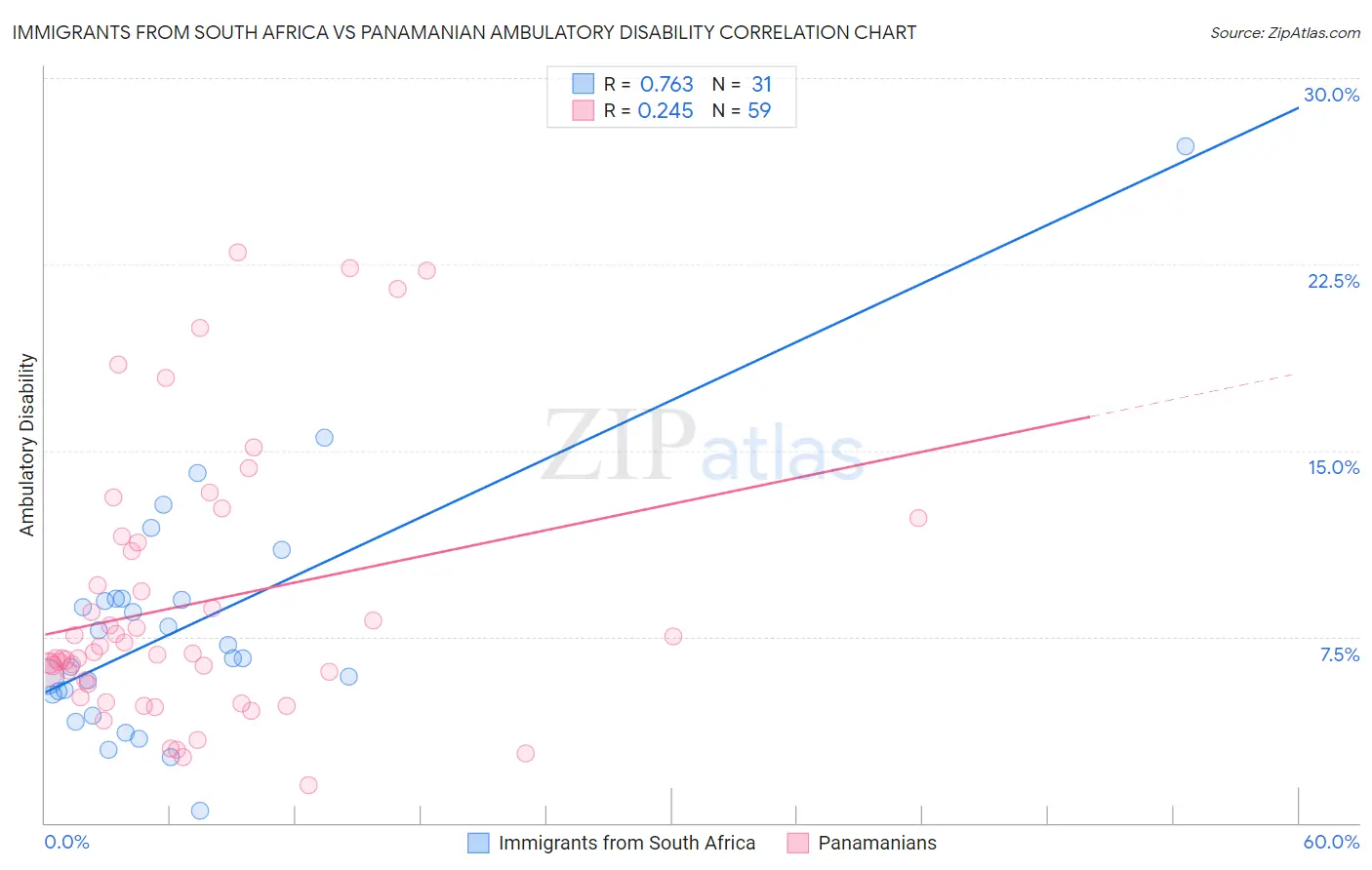Immigrants from South Africa vs Panamanian Ambulatory Disability
COMPARE
Immigrants from South Africa
Panamanian
Ambulatory Disability
Ambulatory Disability Comparison
Immigrants from South Africa
Panamanians
5.7%
AMBULATORY DISABILITY
99.3/ 100
METRIC RATING
75th/ 347
METRIC RANK
6.4%
AMBULATORY DISABILITY
3.1/ 100
METRIC RATING
231st/ 347
METRIC RANK
Immigrants from South Africa vs Panamanian Ambulatory Disability Correlation Chart
The statistical analysis conducted on geographies consisting of 233,268,950 people shows a strong positive correlation between the proportion of Immigrants from South Africa and percentage of population with ambulatory disability in the United States with a correlation coefficient (R) of 0.763 and weighted average of 5.7%. Similarly, the statistical analysis conducted on geographies consisting of 281,171,683 people shows a weak positive correlation between the proportion of Panamanians and percentage of population with ambulatory disability in the United States with a correlation coefficient (R) of 0.245 and weighted average of 6.4%, a difference of 12.0%.

Ambulatory Disability Correlation Summary
| Measurement | Immigrants from South Africa | Panamanian |
| Minimum | 0.47% | 1.5% |
| Maximum | 27.3% | 23.0% |
| Range | 26.8% | 21.5% |
| Mean | 7.8% | 8.8% |
| Median | 6.6% | 6.8% |
| Interquartile 25% (IQ1) | 5.2% | 5.6% |
| Interquartile 75% (IQ3) | 9.0% | 11.3% |
| Interquartile Range (IQR) | 3.8% | 5.7% |
| Standard Deviation (Sample) | 5.0% | 5.3% |
| Standard Deviation (Population) | 4.9% | 5.3% |
Similar Demographics by Ambulatory Disability
Demographics Similar to Immigrants from South Africa by Ambulatory Disability
In terms of ambulatory disability, the demographic groups most similar to Immigrants from South Africa are Sudanese (5.7%, a difference of 0.020%), Immigrants from Cameroon (5.7%, a difference of 0.050%), Immigrants from Northern Africa (5.7%, a difference of 0.060%), Brazilian (5.7%, a difference of 0.070%), and Immigrants from Peru (5.7%, a difference of 0.090%).
| Demographics | Rating | Rank | Ambulatory Disability |
| Sri Lankans | 99.6 /100 | #68 | Exceptional 5.7% |
| Peruvians | 99.5 /100 | #69 | Exceptional 5.7% |
| Sierra Leoneans | 99.4 /100 | #70 | Exceptional 5.7% |
| Immigrants | Peru | 99.4 /100 | #71 | Exceptional 5.7% |
| Brazilians | 99.4 /100 | #72 | Exceptional 5.7% |
| Immigrants | Northern Africa | 99.4 /100 | #73 | Exceptional 5.7% |
| Immigrants | Cameroon | 99.4 /100 | #74 | Exceptional 5.7% |
| Immigrants | South Africa | 99.3 /100 | #75 | Exceptional 5.7% |
| Sudanese | 99.3 /100 | #76 | Exceptional 5.7% |
| Immigrants | Vietnam | 99.3 /100 | #77 | Exceptional 5.7% |
| Somalis | 99.2 /100 | #78 | Exceptional 5.7% |
| Chileans | 99.2 /100 | #79 | Exceptional 5.7% |
| Immigrants | Ireland | 99.2 /100 | #80 | Exceptional 5.7% |
| Immigrants | Jordan | 99.2 /100 | #81 | Exceptional 5.7% |
| Palestinians | 99.2 /100 | #82 | Exceptional 5.7% |
Demographics Similar to Panamanians by Ambulatory Disability
In terms of ambulatory disability, the demographic groups most similar to Panamanians are Mexican (6.4%, a difference of 0.16%), Czechoslovakian (6.4%, a difference of 0.26%), Portuguese (6.4%, a difference of 0.31%), Cuban (6.4%, a difference of 0.32%), and Assyrian/Chaldean/Syriac (6.4%, a difference of 0.33%).
| Demographics | Rating | Rank | Ambulatory Disability |
| Liberians | 7.1 /100 | #224 | Tragic 6.3% |
| Hondurans | 6.3 /100 | #225 | Tragic 6.3% |
| Slavs | 5.1 /100 | #226 | Tragic 6.4% |
| Cubans | 4.0 /100 | #227 | Tragic 6.4% |
| Portuguese | 4.0 /100 | #228 | Tragic 6.4% |
| Czechoslovakians | 3.8 /100 | #229 | Tragic 6.4% |
| Mexicans | 3.5 /100 | #230 | Tragic 6.4% |
| Panamanians | 3.1 /100 | #231 | Tragic 6.4% |
| Assyrians/Chaldeans/Syriacs | 2.4 /100 | #232 | Tragic 6.4% |
| Sub-Saharan Africans | 2.3 /100 | #233 | Tragic 6.4% |
| Immigrants | Liberia | 2.3 /100 | #234 | Tragic 6.4% |
| Hispanics or Latinos | 2.2 /100 | #235 | Tragic 6.4% |
| Dutch | 2.0 /100 | #236 | Tragic 6.4% |
| Immigrants | Germany | 1.8 /100 | #237 | Tragic 6.4% |
| Haitians | 1.8 /100 | #238 | Tragic 6.4% |